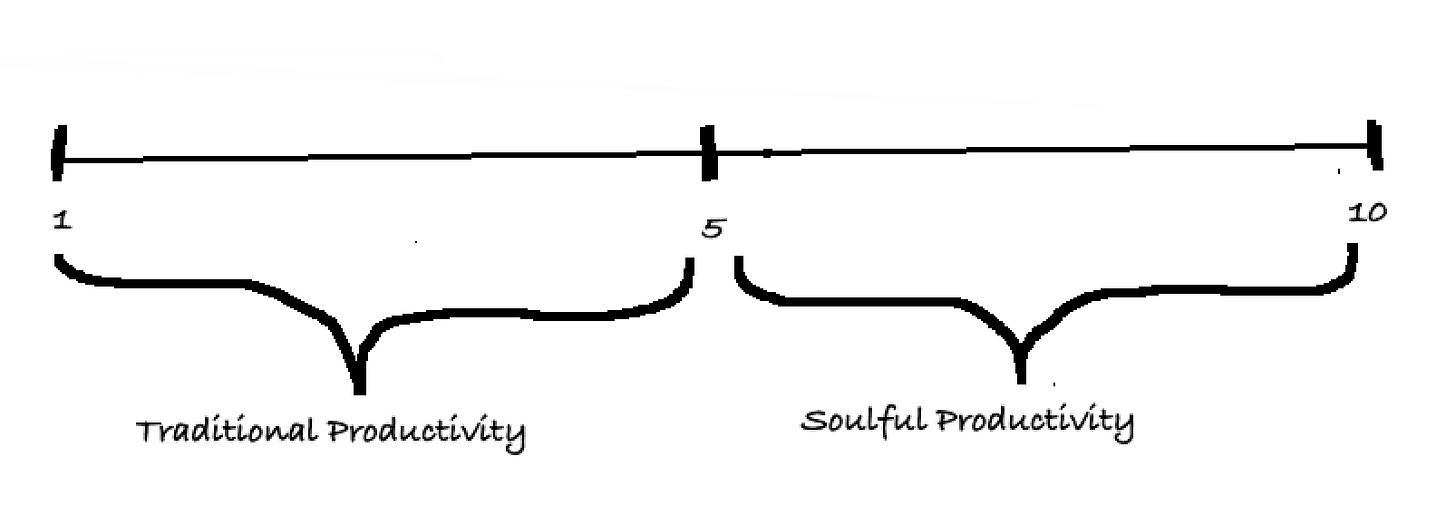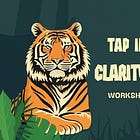Your Soulful Productivity Starter Kit 🏁
Traditional productivity has hurt your soul. Soulful productivity can help heal it.
As I’m continuing to develop my concept of Soulful Productivity, I thought it might help to create a Starter Kit for you, and explain how Soulful Productivity fits into how you can have a good life.
As you might know, this entire publication is about Joyful Growth. To me, that means that we grow and develop in a way that feels good.
💡 Growth is inevitable. The only choice we get is between:
1. growing through joy, or
2. growing through suffering. I’ve chosen to call the first approach Joyful Growth, and the second one Traditional Growth.
Joyful Growth doesn’t mean that we will never feel pain or experience hardship and challenges. The last few months have certainly felt incredibly challenging to me. You might have had a similar experience.
However, we can strive to live according to the Buddhist teaching that while pain is inevitable, suffering is optional. In other words, it’s inevitable that undesirable things happen (pain). What’s optional is whether we make them worse through our thoughts, emotions, or actions (suffering).
My concept of Joyful Growth takes this a step further: finding the positive things in our challenges. To give a personal example: while the last few months have been super-challenging for me, they have also made me more mature, strong, and resilient.
Perhaps you have also experienced positive things during recent times of challenges?
Joyful Growth in different areas of life
💡 We can apply this distinction between Joyful Growth and Traditional Growth to all areas of life.
Here's what this looks like: There’s an old way of doing things (that entails at least some suffering) and a newer, more joyful way (that doesn’t view suffering as a necessity). For instance, traditional relationships might include aspects of imbalance (such as overgiving) and inauthenticity (playing a role). In contrast, a truly joyful relationship is one where we can really be ourselves, and the other person(s) can do the same.
Shortly after my spiritual awakening about 15 years ago, I had a discussion with someone close to me. I had started to show up more authentically in that relationship, and this person was wanting me to go back to how I used to be. When I refused to, they said I was threatening the relationship. To which I exclaimed:
“If I can’t be myself, it’s not really a relationship!”
This story has a happy ending: this relationship, like all of my close relationships, is now much more authentic than it used to be. The moral of the story is that it can be confronting for those around us when we change a lot—but if a relationship is strong enough, it will be able to adjust to our new self.
Joyful Growth in our work
While we can apply Joyful Growth in all areas of life, one area is particularly close to my heart: work and productivity.
💡 Soulful Productivity is what Joyful Growth looks like when applied to our work life and productivity.Work and productivity can feel good. It can also feel bad. Since both of these are valid options, it makes a lot more sense to opt for the one where things feel good, right?
But it’s about more than just feeling good, there are deeper implications to the choice between Soulful Productivity and Traditional Productivity.
Traditional Productivity has hurt your soul — Soulful Productivity can help you heal it
Chances are that Traditional Productivity has hurt your soul. It is based on the belief that in order to be worthy, you need to be productive. As a result of that belief, Traditional Productivity motivates us to go to extremes to prove our worth.
For instance, it might have gotten you to:
overextend yourself to the detriment of your health,
neglect your family or friends, or even
do things that felt borderline unethical to you.
💡 Traditional Productivity is based on the toxic belief that your worth depends on your productivity.
Soulful Productivity is based on the belief that you are worthy simply because you exist. To me, that belief is the crucial difference between Traditional Productivity (which often feels somewhat bad) and Soulful Productivity (which can have its challenges but overall feels really yummy).
Related articles:
Of course, this is not a binary yes-or-no situation, it’s more of a scale:
The Soulful Productivity Scale
Using a scale to track areas we care about can be extremely helpful in improving things. If you like, you can rank your work and productivity on a scale of 1 (hate my work) to 10 (I am doing what I love in a way that I love with people that I love).
The closer you are to 1, the more you are currently on the path of Traditional Productivity.
The closer you are to 10, the more you are currently on the path of Soulful Productivity.
➡️ You can also use this scale to rank different work-related activities: for instance, perhaps your writing is an 8 on the scale… but you have a day job that doesn’t get above a 3. Or there are certain aspects of your work (for instance, teaching people) that you love, and others that you hate (for instance, admin stuff).
💡 By using the Soulful Productivity Scale, you can create more awareness, and gradually shift more towards “high-scale” activities. The 3 principles of Soulful Productivity
The following 3 principles can help you become more productive in a way that feels good:
clarifying priorities,
setting boundaries,
managing polarities.
1. Clarifying priorities
Today, many people have more freedom than at any other time in history—both in their personal and professional life. However, if you have an overwhelming number of options and no idea which one to choose, freedom of choice turns into a prison.
True freedom comes from being clear on
✅ your current overall priorities in life, and
✅ your priorities on a smaller scale (quarterly, monthly, weekly, etc.)When I start working with a new coaching client, I first help them get clear on their most important goals (= priorities) for the next year. The main goal is generally something Dr. Brian Whetten calls a “Yes Yes Hell No.”
That might seem like a pretty strange name but it will make sense in a moment.
“Yes, Yes, Hell No” considers three perspectives when making a decision:
intuition
reason
fear.
Often, my client’s most important goals are those that receive a “Yes, Yes, Hell No” response:
Your intuition lights up (the first “yes”) ✔️
Your reason thinks it makes sense (the second “yes”) ✔️
Your fear tells you to run the other way (the “hell no”) ❌
“Yes, Yes, Hell No” goals are aligned and get you out of your comfort zone — all while making sense from a rational point of view. Pursuing these types of goals will help you forge your own life path.
If you are interested in learning more about how to identify your Yes Yes Hell No goals, check out the following workshop (for paid subscribers):
💡 Further resources on clarifying priorities:
For more of my thoughts on how to clarify your priorities on a smaller scale, watch the videos below and check out my article How to Quickly Plan Your Day for Maximum Productivity.2. Setting boundaries
To follow through on our priorities, we often have to set boundaries… with ourselves and others. As teacher and author Dawn Clark puts it:
“Focused energy produces results.”
Speaking of results, I have identified the closest thing to a magic pill (hooray!)
It’s the solution to a lot of challenges I see clients struggle with (stress, lack of focus, overwhelm…).
Not only that, it may well be the first step to most things you want in life.
And while it’s not exactly easy, it’s so simple that even a two-year-old can do it. (Especially a two-year-old!)
Ready?
It's actually a magic word.
No, it’s not Abracadabra.
It’s much easier to pronounce.
💡 The magic word that helps you set boundaries is: No! (Or “non,” “nein” or whatever the equivalent is in your language.)
That’s right.
“No” is the closest thing to a magic pill I’m aware of.Do you want to be super-productive at work?
Begin by saying “no” to the things that are wasting your time. (Of course, avoiding all of them is often not possible but even a little can go a long way.)Do you want to start a new business?
Begin by saying “no” to the things that take up your time and distract you from focusing on it. (This could include Social Media etc.)Do you want to find the right person to be with?
Begin by saying “no” to the wrong people. (This may first require figuring out how to tell what category someone falls into.)
You might wonder what makes the word “no” so powerful. I think it is because it’s connected to priorities. By consciously saying “yes” and “no,” you can build a life based on your priorities.
The bottom line? Your “no” protects your “yes.” By saying no to what matters less, you make space for what matters most.
As Richie Norton put it:
“Say no to everything, so you can say yes to the one thing.”
💡 Resources related to setting boundaries:
For more of my thoughts on this topic and practical advice for getting better at saying no, watch the video below and check out my article Saying No: How the Magic of This Word Can Free You:3. Managing polarities
Getting clear on your priorities and setting boundaries is not enough. To navigate life in a skillful way, we also need to learn how to manage polarities!
Let’s talk about one of the most important distinctions I’m aware of (thanks to Barry Johnson who created Polarity Management): the difference between
problems and
polarities.
💡 This distinction between problems and polarities is crucial because it helps us determine if a challenge we face is solvable (indicating a problem) or only manageable (indicating a polarity).For instance, the question “Should I leave my job?” indicates a solvable problem. The same is true of the question: “Should I stay in my job?”
💡 Problems tend to have an either/or answer. You either stay in your job or not. Staying or leaving is a concrete action step that you can choose to take or not.In contrast, the question “Should I focus on my immediate or my longterm priorities?” has a both/and answer. It is not solvable because one would ideally focus on both immediate and longterm priorities.
This question does not indicate a problem, but a polarity — the polarity between immediacy and longterm.
💡 Unlike problems, polarities are ongoing and need a both/and approach. Here’s what to do when you are presented with an productivity challenge:
Identify if the challenge is a problem or a polarity:
Problems typically have an either/or answer, whereas polarities have a both/and answer. Problems are typically limited in time, whereas polarities are ongoing. Problems can be solved, whereas polarities can only be managed. If you want to work from home, but your employer wants you in the office, it’s a problem and therefore at least technically solvable (for instance, if one of you compromises, or if you decide to quit and find a differnet job).If your challenge is a polarity, identify the two poles of it:
For instance, if you feel tired from work, you may be dealing with the polarity between action and rest. (Note that both poles have a positive or neutral label. This is intentional, because both poles are important.)Identify which pole you generally tend to gravitate more to:
Oftentimes, when we are presented with a polarity, we tend to favor one side over the other. For instance, you may be an energizer bunny and avoid taking a break until you almost pass out from exhaustion, or you may be so chilled out that you never do the things you intend to do.Identify the negative effects that come from focusing on one pole:
When we focus too much on one side of the polarity, we make things harder than they need to be. This is because polarities tend to be interdependent, not oppositional. If we ignore one pole and go overboard with the other, both poles suffer. For instance, if you only focus on taking action and don’t get enough rest, at some point you may start to burn out… and be forced to take an extended break. Thus, ignoring the “rest” pole may have a negative impact on the “action” pole, too.Start focusing more on the other pole — without overdoing it:
In contrast, if you took adequate (as opposed to excessive) time and energy to rest, it would be much harder to burn out. Thus, by adequately dealing with the “rest” pole, the “action” pole also benefits.
Just remember to not go overboard with it.
The following quote from Ashleigh Brilliant always cracks me up:
“I don’t have any solution, but I certainly admire the problem.”
When it comes to unsolvable productivity challenges, this is actually a good attitude to have. Polarities don’t have a solution and the sooner we accept that, the sooner we can start managing them.
By following the 5-step process above, you can get started right away!
💡 Resources related to managing polarities:
For more of my thoughts on navigating the polarity between rest and productivity, check out the article below: ↪️ Putting this all together ↩️
Where are you on currently on the Soulful Productivity Scale between 1 and 10?
What is your most important priority in your work?
What boundaries do you need to set?
How can you get adequate rest? Are there other polarities you need to manage? (For instance, between doing things for other people, and doing things for yourself?)
This 5-minute meditation brings the 3 principles of Soulful Productivity together (downloadable version available here):
Warmly,
Louise
P.S.: If you have questions about this Starter Kit or Soulful Productivity in general, please comment below. And if you know somebody who could use this, please consider sharing it with them. Your support helps me reach more people!








